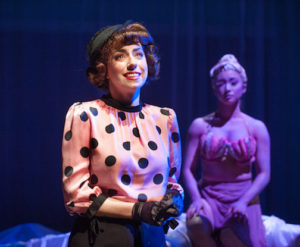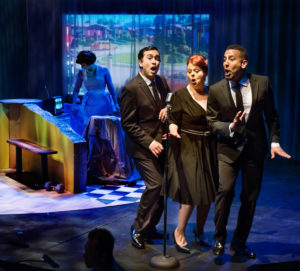Opera Parallèle celebrated the centennial of Leonard Bernstein’s birth this past weekend in a performance that included two short operas and several dramatized musical pieces woven into a loose narrative, rather like the one-act that was the finale of the evening, Bernstein’s Trouble in Tahiti.
Perhaps in honor of their collaboration with SFJAZZ at the Center where the performance was held, the evening began with a jazz-infused selection from West Side Story, blazingly played by pianist Keisuke Nakagoshi with percussion support from Joel Davel.
On stage, dancer Steffi Cheong entered and posed as the statue of Venus, and people walked on the platform above her, looking at collages projected on the wall as if they were viewers at a museum.
Sax player Michael Hernandez joined the duo, followed by a low hum of strings, then winds and brass. Baritone Eugene Brancoveanu stepped into the spotlight above the stage to sing the gripping “Something’s Coming,” focusing the audience’s attention on the question of love and how it haunts us, thrilling the mind with anticipation and longing.

The museumgoers moved the audience’s attention smoothly to the statue below, and the music shifted to Charles Ives’ The Unanswered Question, a piece near to Bernstein’s heart. The chamber orchestra directed by Opera Parallèle Artistic Director Nicole Paiement included the finest contemporary music musicians of the Bay Area. While they came to easy grips with Ives’ iconic work, the statue of Venus came to life. Cheong’s dancing, choreographed by Amy Seiwert, had both gravity and an enigmatic quality suitable to the music and moment. As the music subsided, the dancer stilled into her role as statue.
The restless inquiry of Ives’ work found its home next in the central character of Jake Heggie and Terrence McNally’s At the Statue of Venus. A young woman named Rose (Renée Rapier) enters the museum and sits at the foot of the statue. She is waiting for a blind date. Her long monolog set to music reveals all her inner anxiety. Why did she wear slacks? What did it mean that her date wanted to meet at “5-ish”? Will she be a “masterpiece” to him like the painted women on the walls of the museum? (At this point the collages by Sherri Parker morphed into animation, reflecting her fears.)
At the Statue of Venus highlights how underrated librettists are: for without the complexity of McNally’s psychological portrait of Rose this short piece would not have the impact it does. It is only in the last lyrical breaths of the opera, when Rose sings about the roots of her longing and fears, tenderly revealing her memories of a sweet, “lucky” childhood, that the music rises to engulf the words, and sound – pure and abstract – becomes the emotion – pure and abstract.

After the intermission, the program moved into its most brilliant theatrical moments. Bernstein’s Trouble in Tahiti was the only work in which the composer wrote both the lyrics and the music. Written in 1951, it’s a sly comment on the emotional void of the suburbs, home to the American Dream. It opens with a trio of singers, a kind of jazz Greek chorus, alternating between verses about “the little white house in suburbia” and scat nonsense syllables. In the background, a projected 1950s magazine illustration of a leafy green avenue with quiet houses overlooks the set, which is on a large turntable-like stage divided into four sections. The sections define the parameters of suburban life: the breakfast nook, the faux oak desk at the company office, two facing chairs at the psychologist’s office, a standing bicycle at the gym.
Into this clearly defined world steps our unhappy couple: Dinah (Renée Rapier) and Sam (Eugene Brancoveanu). Their morning conversation is a series of squabbles interrupted by pleas for better behavior. As they move into their various worlds outside the home: Sam to his office, where the trio joins him to sing of his business savvy (“Oh Sam, you marvelous man!”) and Dinah to her therapist, where she sings to a wordless man of a long dream she had, filled with longing.
As they move through their lives, Bernstein surefootedly shifts the music through genres, from jazz to art song, each reflecting the internal moods of the characters. It’s a sweet tour de force, encapsulating brilliantly the composer’s genius.
Artistic Director Nicole Paiement’s conducting was immaculate throughout and Creative Director Brian Staufenbiel and his production team evolved staging that treated the work with freshness, humor and insight. The media work by David Murakami was spot-on, as was Dave Dunning’s scenic design.
As always, Opera Parallèle fills our lives with the very best of contemporary opera.
–Jaime Robles
For more information about Opera Parallele’s future productions and their community work, visit operaparallele.org.
